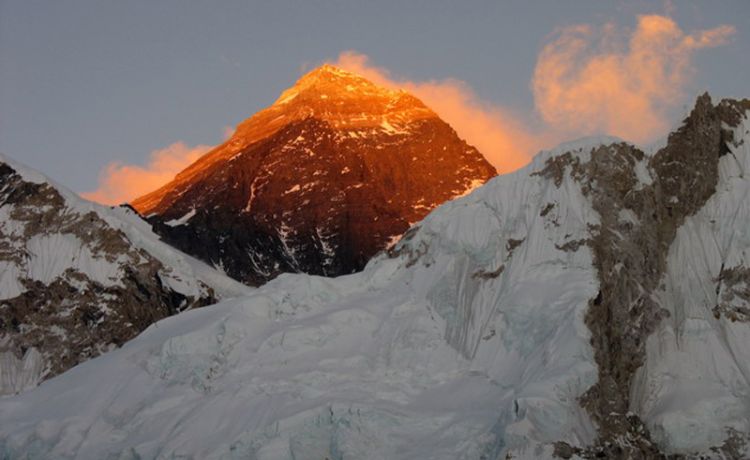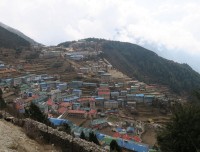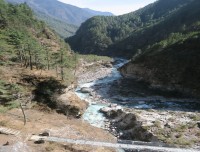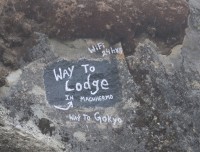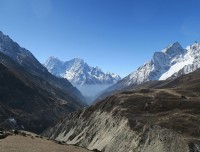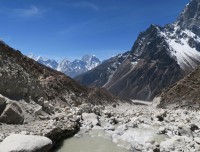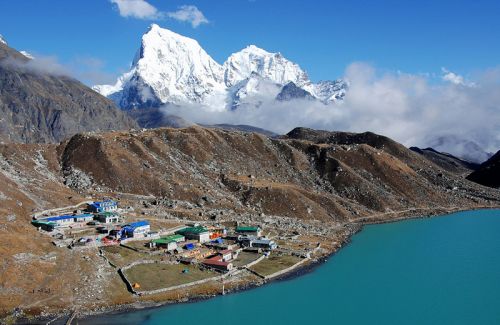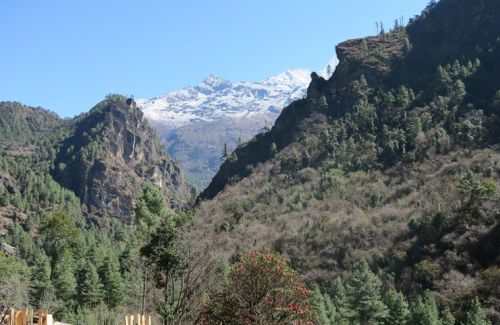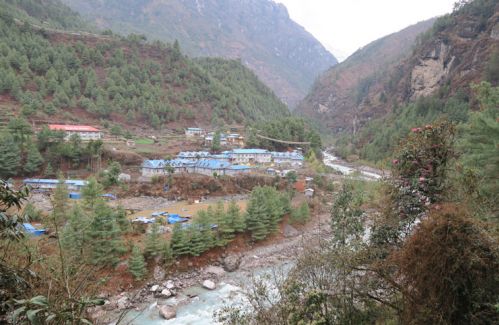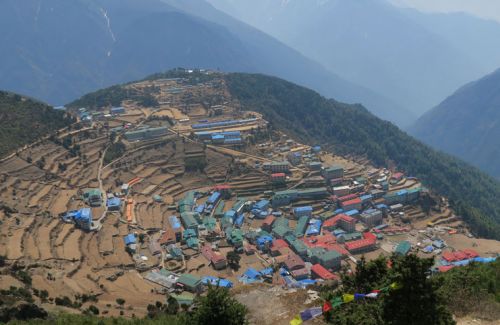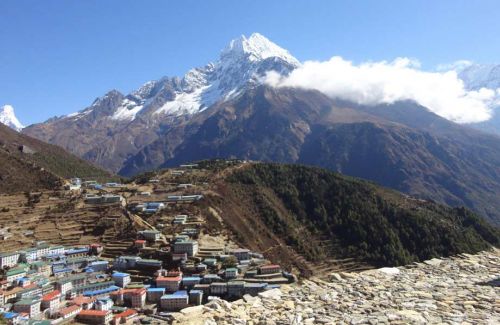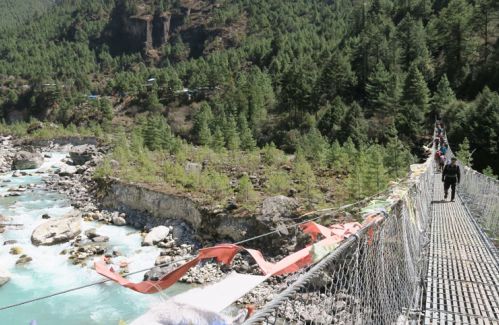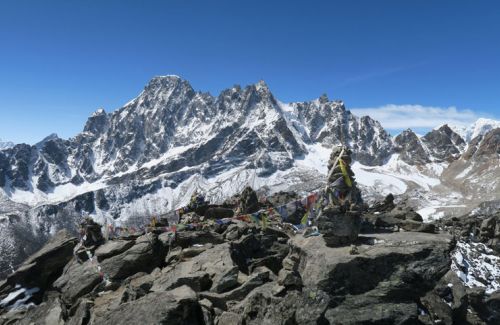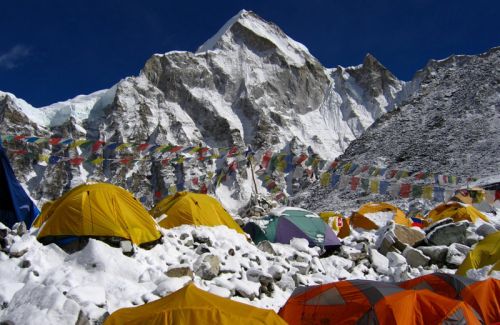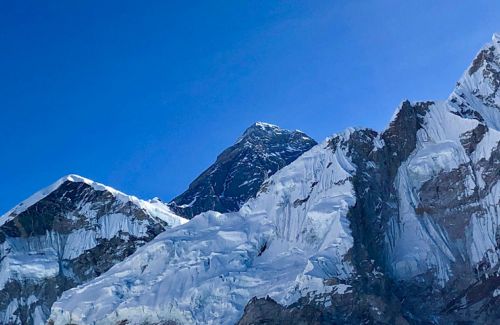Everest Circuit Trekking
- Duration18 Days
- Max. Altitude5,545 m
- Starts FromUSD 1630
Destination:Nepal
Trip Grade:Strenuous (****)
Meals:Breakfast + Lunch + Dinner
Transportation:Private Vehicle / Aeroplane
Accommodation:Lodge
Season:September to Late December & February to Late June
Show AllEverest Circuit Trekking is one of the daring, tough route, goes through three high passes Kongma La (5,535 m), Cho La (5,420 m) and Renjo La (5,340 m). Trek to Everest Circuit, takes us to the Everest Base Camp, Kalapatthar, Gokyo Valley and its sparkling blue lakes,Gokyo Ri for awesome views of the landscapes.This route introduces trekkers to the virgin Nangpa La Valley, the Sherpa village of Marlung and the ornately decorated monastery village of Thame. The prime attractions of this route are : Mt. Everest, Sagarmatha National Park, designated as a World Heritage Site in 1979, much of the 1148 sq.km lies above 3000 m. The park is full of deep gorges, glaciers, huge rocks, many different species of flora and fauna. It is the home to two other eight thousand meter high mountains like Mt. Lhotse and Mt. Cho-Oyu and prominent peaks above 6,000 m high.
After we land at Lukla, we proceed our trek via Dudh Koshi River to its source, the Gokyo Lake that is to the west of Everest Base Camp. We reach to Namche Bazar, a delightful village nestled in horseshoe-shaped valley, a trading center where the weekly market held on Saturday, colorful and well worth seeing. It is a good place to rejuvenate after the rigors of the heights. After Namche Bazaar,we trek above the tree line and the rhododendron forests and after a while a clear of trees, the mountains offer “gee whiz” sights in all directions,we pass herds of yaks grazing the mountain pastures with their bells chiming in the distance. We take a less traveled road to Phortse Tenga,which lies a short distance from the traditional Sherpa village of Phortse. Then we hike up passing through Dole and Machermo before reaching Gokyo. We climb up to Gokyo Ri for the sunrise. As we cross Cho-La pass,we descend down the valley toward Lobuche then gently ascend to Khumbu glacier to Everest Base Camp, up to closeup views of the Khumbu Icefall and return to Gorakshep for another summit of Kalapattar. Thus, the magnificent view point allows the closest and clearest view of Everest.Finally,this Everest Circuit Trekking is a combination of Everest Base Camp and Gokyo lake linked by the climb over the challenging Cho La pass.
Trip Highlights
- Combination of three different places: Everest Base Camp, KalaPatthar and Gokyo
- Explore the Sherpa museum in Namche
- Exotic view of virgin Nangpa La Valley
- Sherpa Village of Marlung
- Ornately decorated monastery of Thame
- Sagarmatha National Park
Day to Day Itinerary
Day 01:Arrival in Kathmandu (1,350 m) and Transfer to the Hotel
Day 02:Kathmandu Sightseeing and Trek Preparation
Day 03:Fly to Lukla (2,800 m) – then Trek to Phakding (2,652 m) – 3 hours
Day 04:Phakding – Namche Bazaar (3,440 m) – 6 hours
Day 05:Namche Bazaar – Day to take rest and to acclimatize
Day 06:Namche Bazaar – Phortse Tenga (3,680 m) – 5 hours
Day 07:Phortse Tenga – Machhermo (4,470 m) – 5 hours
Day 08:Machhermo – Gokyo (4,790 m) – 6 hours
Day 09:Gokyo – Trek to Gokyo Ri (5,483 m) Then back to Gokyo – 5 hours
Day 10:Gokyo – Thangna (4,500 m) – 4 hours
Day 11:Tangna – Cross Cho La Pass (5,300 m) and Trek to Dzong La (4,710 m) – 7 hours
Day 12:Dzong La – Lobuche (4,910 m) – 4 hours
Day 13:Lobuche – Trek to Everest Base Camp (5,365 m) Then Back to Gorak Shep (5,170 m) – 7 hours
Day 14:Gorak Shep – Hike up to KalaPatthar (4,280 m), Then trek down to Pheriche (4,280 m) – 7 hours
Day 15:Pheriche – Namche Bazaar (3,440 m) – 6 hours
Day 16:Namche Bazaar – Lukla (2,800 m) – 6 hours
Day 17:Fly from Lukla to Kathmandu in the morning, ( Farewell Dinner in the Evening)
Day 18:Departure to the International Airport
Cost Include
- Airport Pick up and Drop
- Kathmandu City Tour
- Kathmandu – Lukla – Kathmandu flight
- HOTEL IN Kathmandu with Breakfast( Hotel Category as per your choice)
- Lodge to lodge accommodation during trekking
- Full Board meal during the trek
- English Speaking trekking guide
- Food, accommodation, salary, insurance. equipment and medicine for guide and porter
- Trekking permits and National Park fees
- All the taxes for the Government
- Farewell Dinner
Cost Exclude
- Lunch and Dinner in Kathmandu
- Travel and Rescue Insurance
- Personal Expenses (Phone Calls, Laundry,Bar bills, Battery Recharge, Bottled or boiled water, Shower etc.)
- Tips for guide and porter
- Personal Trekking Equipment
- Any other expenses which are not mentioned in Cost Includes Section)
Detail Itinerary
Day 01Arrival in Kathmandu (1,350 m) and Transfer to the HotelYou are welcomed genially in the airport by Himkala representatives and transfer to the hotel. You can have rest for the next day’s city tour in the UNESCO World Heritage Sites. If you like to walk around, you can visit the local market, touristic place at Thamel. Overnight at Kathmandu
Day 02Kathmandu Sightseeing and Trek Preparation The day is very much significant to understand the culture, history, ritual activities, medieval periods’ arts and architecture. After the city tour, we come back to hotel and there is briefing about the trekking in the evening. Overnight at Kathmandu
Day 03Fly to Lukla (2,800 m) – then Trek to Phakding (2,652 m) – 3 hours We fly to Lukla (2,800 m) in the early morning.The flight from Kathmandu to Lukla take 40 minutes and give a heart – pounding peak tour as the small plane goes in to the Dudh Koshi Gorge. We begin our trek gradually and within 3 hours we reach to Phakding. Leaving Lukla the trail clamours over the steep sided Dudh Koshi valley crossing many streams and meandering through forests of blue pine, fir, juniper, rhododendron, birch and oak. We also pass mani walls, prayer wheels and colorful prayer flags that become our constant companions in this Buddhist Land. The little farms and hamlets we pass are a delight, with their terraced fields separated by stone walls covered with colorful ferns and moss. Overnight in Phakding
Day 04Phakding – Namche Bazaar (3,440 m) – 6 hours Phakding is a small village with many lodges, usually of dormitory style: one large room with many simple wooden beds.After fueling up on early breakfast, we start our trek around narrow bench lands cultivated in wheat, potatoes, radishes and onions. The trail climbs and falls repeatedly then crosses to the other side climbing up a cleft in the canyon wall to reach Monjo (2,835 m). The trail continues to gradually climb toward the next village Jorsale (2,774 m). You can catch the glimpse of towering ridge ahead, the Namche Bazaar in between two villages. Descending a natural stone staircase we pass a huge rock and drop down to cross suspension bridge below.Continuing up the west bank through forests, the trail finally reaches the confluence of the Bhote Koshi and the Dudh Koshi . It is the west fork we follow the Swiss funded suspension bridge and the climb begins to Namche Bazaar. After gueling ascent, it’s the first time to view the first sight of Mt. Everest and Lhotse. Overnight at Namche Bazaar Overnight at Namche Bazaar
Day 05Namche Bazaar – Day to take rest and to acclimatize Namche is a delightful village nestled in a horseshoe – shaped valley.. Sherpa culture thrives in this town and many trekkers hike up to the Sagarmatha National Park Museum on their rest day to keep their legs and lungs strong. We can visit Kunde (3,850 m) which is famous for the hospital built by Sir Edmund Hillary. Overnight at Namche Bazaar
Day 06Namche Bazaar – Phortse Tenga (3,680 m) – 5 hours Early the morning, with renewed spirit and strength, we set out toward the small saddle that rises to the east of town toward the Sagarmatha National Park Museum. Take the trail which contours around the ridge, high above the Dudh Koshi. You can enjoy the stunning snow peak views emerge around every corner turn and you may be able to spot musk deer grazing nearby. The trail drops down the ridge toward the river and continues through the forest and small villages. There is a small settlement (3,680 m) called Pungo Tenga or Phortse Tenga which as many water mills and a series of water driven prayer wheels. Overnight at Phortse Tenga
Day 07Phortse Tenga – Machhermo (4,470 m) – 5 hours The trek from Phortse Tenga to Machermo is not difficult though we have to prepare ourselves for the next five hours climb. When we cross over the Bridge of Dudh Koshi River, we may spot some wild lives active on the way through forests. After crossing waterfalls and other bridges, we reach to Dole (4,040 m). There are few lodges and tea houses. We slowly climb up to the ridge of Dole via Lhabarma. While climbing up, we can have gorgeous view of Cho-oyu, Kangtega, Thamserku and we reach at Luza (4,369 m).The trail further goes up to the Dudh Koshi Valley passing some small hamlets and sandy spurs, we arrive at Machhermo. Machhermo is the last main settlement on the way to Gokyo. The gushing crystal clear stream from Kyajo Ri and Phari Lapche goes through the middle of the village and mixes in to the Dudh Koshi River. This is the place where there is Himalayan Rescue Hospital for the primary treatment of AMS, given information about precaution. Overnight at Machhermo
Day 08Machhermo – Gokyo (4,790 m) – 6 hours After Machhermo, we climb through a ridge and the views of valley and the Mt. Kangtega, Thamserku and Cho-Oyu seems stupendously amazing. Beyond the ridge, the valley flattens; the trail passes through a Chorten and reaches Pangka (4,480 m). We steadily descend to the river bank before beginning to climb up to the moraine of Ngozumpa Glacier. We cross the iron bridge, pass the first lake Longpongo at an elevation of 4,690 m and follow the valley. It is good opportunity to see the Lama footprints on the stone. Taboche Tsho, the second Lake shows its glistening beauty. Gokyo village stands by the third Lake, Dudh Pokhari. Overnight at Gokyo
Day 09Gokyo – Trek to Gokyo Ri (5,483 m) Then back to Gokyo – 5 hours We can have good rest at Gokyo but it is better to be active. If the weather does not conceit, then we can better climb Gokyo Ri. Gakyo has gained its popularity not only because of its grandeur beauty but also its six lakes. The fourth lake Thonak Tsho, fifth Lake Ngozuma Tsho should not be missed.Thonak Tsho is 3 km north of Gokyo. The trail leads till fifth Lake offer a grand views of Cho-Oyu, Ghyachung Kang, Everest, Lhotse, Nuptse and Makalu. There is Cho-Oyu Base Camp and the biggest Ngozumpa Glacier beyond the fifth Lake. After the great hike, we get back to Gokyo. Overnight at Gokyo
Day 10Gokyo – Thangna (4,500 m) – 4 hours After capturing the great view of Gokyo , we trek down to Thangna. It’s the descend viewing awesome mountain scene and valley. Thangna, situated at the shore of the Ngozumpa glacier, is considered as the base of Cho La pass. Overnight at Thangna
Day 11Tangna – Cross Cho La Pass (5,300 m) and Trek to Dzong La (4,710 m) – 7 hours After the breakfast, we head towards Cho La Pass ascending slightly along the valley. It is the rocky, precipitous region covered by the ice make you feel solitary in the wild adventurous journey but at the same time the panoramic view of mountains overlaps your anxiety and revitalize. From here, the trail further descends down abruptly for an hour all the way to Dzongla. Overnight at Dzongla
Day 12Dzong La – Lobuche (4,910 m) – 4 hours The trail from Dzongla fluctuates gently above the glaciated lake and passes through the Cholatse, Taboche, the beautiful peaks and the Chola glacier. Siezing the view of Ama Dablam, following the hill trail, we turn towards the north and go down to the valley which is the end of Khumbu glacier and reach to Lobuche after a while. Lobuche may not be your ideal place to stay but another 3 hours trek to Gorakshep may exhaust you, so it is better to compromise for the night stay. Overnight at Lobuche
Day 13Lobuche – Trek to Everest Base Camp (5,365 m) Then Back to Gorak Shep (5,170 m) – 7 hours After our breakfast we proceed towards the Everest Base Camp through the Gorakshep Lake. We pass the Indian Mountaineer’s Memorials after following the same trail from Gorakshep Lake. You might feel uneasy because of thin air in the high altitude through rocky ridges, moraine and streams before we reach to the Everest Base Camp. It is place from where we can view colorful tents standing and the brilliant scene of Nuptse, Khumbutse and Pumori. We return back to Gorakshep for the overnight stay. Overnight at Gorakshep
Day 14Gorak Shep – Hike up to KalaPatthar (4,280 m), Then trek down to Pheriche (4,280 m) – 7 hours We are hiking up to KalaPatthar in the early morning for the sunrise and its mild sunrays over the top of Everest slowing coming down and the varied color to witness is not less than any heavenly pleasure. The morning clear view of Mt. Everest and other adjacent peaks are indescribable. From KalaPatthar, without any delay, we go to climb the rocky outcrop near to the summit marked by cairns and prayer flags. After getting adorable sight, we trek down to Pheriche which is about 4 hours trek.Pheriche was once a temporary yak herding area. But now it has got different look with hotels and lodges. There is a Trekkers’ Aid Post set up by Himalayan Rescue Association in 1973. Overnight at Pheriche
Day 15Pheriche – Namche Bazaar (3,440 m) – 6 hours The trek from Pheriche to Namche Bazaar is an easy descending down because you do not have to worry about the altitude problem. After breakfast we set out from Pheriche which is steeper though there are quite a few up hill sections. Along the way, we may see the blue bright Himalayan Pheasant. We come to Namche Bazaar and have nice hot shower in the hotel. In the evening, you can walk around for the internet, bakery,shoping and dinner. Overnight at Namche Bazaar
Day 16Namche Bazaar – Lukla (2,800 m) – 6 hours The trail from Namche Bazaar to Lukla is steep and should walk carefully if you have sores on your feet. We cross the suspension bridge over the Dudh Koshi River and pierce the nice forest covered by pine and rhododendrons. The Sherpa villages with its cultural norms and values fulfill the curiosity noticing some practices they have done, their way of living and the colorful prayer flags etc. When we are at Lukla, it is your time to roam in the memories of your bygone days. Overnight at Lukla
Day 17Fly from Lukla to Kathmandu in the morning, ( Farewell Dinner in the Evening) We fly from Lukla to Kathmandu in the early morning’s flight. Sometimes due to the vagaries of weather, the flight can be cancelled or delayed. The peak scenery through the small plane’s window seems fabulous. After we land at Tribhuvan International Airport, you are transferred to the hotel. It’s now time to spend as you wish. Himkala has arranged the dinner in the Nepalese restaurant with Nepali Cultural Show. Overnight at Kathmandu
Day 18Departure to the International Airport We transfer you to Tribhuvan International Airport, 3 hours before you fly to the next destination. With warm feeling, showing gratitude to you that you joined Himkala for Everest Circuit Trekking, our represents departs from airport and you go ahead for custom formalities. Namaste with palms together
Trip FAQ
Himkala Adventure would like to answer all the queries about Everest Circuit Trekking for all curious travelers/trekkers in the world. As you are entirely from different geographical location, you could better to know everything about the treks from the beginning i.e. airport pick up till your departure like airport picks up, drops off, accommodation in city, in the trek, guide and porters, safety for the trekking, food and accommodation and some other things that you might face on the way. Hope our endeavor listing these questions answers will help you self informed.
This is simply the outlines of the services we offer but it may differ as per your requirement, number of trekkers. What we go through our conversation, we will manage the means of transportation, hotels in the city, accommodation in the trekking, numbers of porters etc. This is general idea about Everest Circuit Trekking before your trip and you become clearer about the trek. Please feel free to contact us to get more information about the trekking in the Himalayas of Nepal.
1) How is Everest Circuit Trekking in Nepal?
Everest Circit Trekking goes through three passes like Kongma La, Cho La and Renjo La. Everest Circuit Trek covers Gokyo Lake, Everest Base Camp and the highest view point Kalapatthar. This trek captivates the great mountain view of Mahalangur ranges.
2) What physical fitness do I need to book this trip?
Every trekking in the Himalayas of Nepal requires the certain level of physical and mental fitness. So, we advise you to be in good physical shape and able to feel comfortable while hiking up and down 7 to 12 miles per day on a trail carrying a day pack of about 10 pounds. Three things could make you confident enough for any trek you would like to do: aerobic, strength and mental.
Aerobic conditioning is important primarily because you will be trekking in thinner air, up to 40% less than at sea level. With good aerobic conditioning, you will be able to better metabolize whatever oxygen is available to you. You should plan on doing at least one hour of aerobic 3 /4 times per week for 1 month or more before your arrival in Nepal. Walking, jogging, cycling, hiking on valley floor to ridge line ascents with day back are some of the excellent forms of exercise, so long as you are strengthening leg muscles and building stamina. Speed is not the essence; stamina, confidence and continuity are. Do as much uphill as possible. If you live in flat area, go to the stadium and use the steps with your pack.
3) Is the Everest Base Camp Trekking hard or easy?
Everest Base CAmp Trekking can be easy and very exciting if you could walk minimum 5 miles a day and does have aerobic shape (with doctor’s approval). The actual trekking is on mostly ground level with a few sections of hill sides - up and down. You should carry more than a light day pack with your jacket, snacks and water bottle. The important thing is that you should acclimatize yourself with higher altitudes for that you need to maintain your health, should have a large fluid intake and always in slow pace in the Himalayas.
4) Is it dangerous to trek to Everest Circuit Trekking?
Yes or No, Yes, because if we do not take proper precautions of Altitude sickness, there is risk of life. So, one should quite aware what is going on. Next thing we have to be careful with the caravan of yaks, occasionally, there is an incident that trekkers get injured due to rock fall by the flock of yaks or who inadvertently bump them off the trail and go down steep to the hill side. So, be always on the uphill side when the yaks pass by!
5) Do I really need to use guide to Everest Circuit trekking?
You are advised to use Guide so that you could feel safer in the unknown area because the guide can tell you the possible danger as they have guided in this region since long. Most importantly, the Himalayan weather is really unpredictable and the Guide can help you to take proper shelter. Nest advantage to be with Guide is you get more knowledge about local culture and you could have easy access to interact with the local people. In 2014, the Nepal Government clearly has stated that the trekkers should have a guide but still it is not seemed in the practicality.
6) How do I find Himkala Adventure for my pick up at the airport?
Our representative from Himkala Adventure will display a small board (placard) of company or your name outside the airport terminal. You will be driven to the hotel by our tourist vehicle.
7) What sort of accommodation do I get in Kathmandu?
Normally we provide standard rooms with twin sharing accommodations at three star or similar category hotels in Kathmandu including breakfast. Accommodation in these cities can be upgraded as per your request. But some of our packages are sold without accommodation in the city.
8) How are tea house facilities during Everest Circuit Trekking?
Tea House is the combination of guest house, restaurant, and social hang out. Tea houses in Everest Circuit Trekking area are highly professional though they are simple but with neat and clean lodging offering fine views and plain but fresh and hygienic food with friendly atmosphere Most of the Tea Houses have running water facility. Many of them have hot water available for bathing. But we discourage our groups from using water heated by wood as lack of firewood in most villages is a big environmental concern in Nepal.
9) What sort of accommodation do I get in trekking?
Guesthouses/Tea Houses/Lodges provide twin sharing single and double rooms and occasionally a dormitory which is basically clean with a mattress and a quilt or blanket. Our company provides the sleeping bag if needed but we always recommend having your own sleeping equipments. You have to share the room with your group member or sometimes with unknown traveler. The toilet is always outside the room with basic facilities.
10) What sort of foods, water and drinks can I expect in trekking?
The foods in the Himalayas are very simple. There are mostly the family members themselves to cook and serve the meal. They are simply trained but experienced because they have been offering such services for many years in this busy route. The food is hygienic, fresh and delicious. We recommend you to drink mineral water or the boiled or using water purification pills or drops.
Most of the foods are cooked in the kitchen of tea houses. They serve you with different varieties of delicious Nepali and continental dishes. The most popular Nepali food is daal bhat (rice and lentils) with some mixed vegetable curry. Garlic soup is popular as it helps you with acclimatization. You could better be vegetarian in the mountains. All hotels in cities and guesthouses in trekking serve the vegetarian food. You can find all common types of drinks like hot chocolates, coffee, tea, hot lemon with honey, ginger tea, soft drinks etc. you will have your breakfast and dinner at the lodges where you will be staying and lunch somewhere on the way to your next destination.
11) What mode of transportation do I use?
We will provide the private transportation for Airport/Hotel/Airport pick up and drop and sightseeing in Kathmandu Valley. We use transportation as based on our cost inclusion section. The transportation varies depending on your requirements at the time of booking the trip.
12) What is the best season for this trekking?
The best season for Everest Circuit Trekking is spring (March to May) and autumn (September to December). These are the perfect time of the year for the breathtaking views of Himalayas with clear and sunny days. But the weather in the mountains is unpredictable.
13) What is the weather and temperature like during the trekking?
The climate in Nepal varies from place to place which can be categorized in different four main seasons. The main seasons in Nepal are spring (March to May), summer (June to August), autumn (September to November) & winter (December to February). The best season to travel in Nepal is autumn (September, October & November) & spring (March, April & May). Weather in the mountains is unpredictable. But the day temperature in Everest Circuit Trekking is comfortable.
14) Who will be guiding me during this trip?
We provide the professional government license holder English speaking trekking guides for our entire trekking trip. We can also provide French, Spanish, Japanese, German or Italian speaking guides as per your preference with extra payment but not guaranteed. All guides will be Nepali people who are carefully selected on the basis of their appropriate experience, leadership skills and personality. They are all trained from Nepal Academy of Tourism and Hotel Management, certified and approved by the Tourism Department of Nepal government. We provide a different city tour guide to guide you in UNESCO World Heritage Sites in Kathmandu. They are the professional license holder guide specialized in culture, history, geography, iconography, archeology and religion with good command over English. Tour guides are specialized in city tour and trekking guides are more in the hiking and trekking in the Himalayas.
15) What sort of experience do your guides have?
Our entire city tour guides have bachelors to Master Degree academic education along with many months tour guiding training from Nepal Academy of Tourism and Hotel Management, Rabi Bhawan, Kathmandu, Nepal. They are fluent in spoken languages and informative about the sites in many aspects. They are quite experienced and dedicated to their job and responsibilities.
Our entire trekking guides have minimum Intermediate to Master Degree academic education with trekking guide training from Nepal Academy of Tourism and Hotel Management, Rabi Bhawan, Kathmandu, Nepal. Many of them are from villages. As they are local, they know more about the routes, necessary precaution to be taken and so on. They have spent many years exploring many parts of the country. They are trained in first aid and able to handle any situation easily. They speak good English and make you know about the places you visit.
16) May I charge my electronic gadgets during Everest Circuit trek?
Most of the places in your tea houses have charging facilities. You can charge your devices by paying some extra money. It’s good if you bring TWO or THREE pin travel adapter and put your gadgets at warm place at night.
17) How much additional money is required for this trip?
It’s a very personal question as expenses depend on habit. Normally, in Kathmandu you can allocate about USD 10 to 15 per person per lunch or dinner. USD 10 to USD 15 per person per day will be sufficient to buy bottles of water, chocolates, pay for a hot shower during the trekking. Other personal expenses will be your own calculation.
18) What is the social and environmental responsibility of Himkala Adventure for this trip?
The situation of environment in Nepal is in considerable stage due to so many factors caused by global warming, human activities, and adverse effects of natural incidents. Nepal is in between two giant countries like China and Nepal. The ozone layer is depleting and the atmosphere is getting heated. So, its direct effect is to the Himalayas that the snow is melting day by day and the sea level is rising. It is due to population growth, people are clearing the forest and the soil is being eroded. As a part of society, and our trekking related activities are directly concerned with the social and environmental things. We are very conscious not litter in the open spaces, to manage garbage properly and make local people aware in this campaign. We are working together with other companies and taking these issues seriously.
19) What is the minimum number requirement for this trip?
We operate individual trip to the group joining trips for Everest Circuit Trek. If you want to do any private trip we are ready to organize for solo traveler as well with some additional charges.
20) Are there communication or internet services during Everest Circuit trek?
All guesthouses/lodges in Everest Circuit Trekking trails have telephones and internet services. They provide the WIFI service with some extra charge which helps to get updated with social Medias, friends or family. All our guides carry the local mobile phone. You can use his mobile phone to make any local or international call from trekking trails by paying him directly. You can even pass him number to be connected with your family or friends. We highly recommend taking local SIM card for call and internet services during trekking. Local SIM cards are easily available in many stores and at airport as well. You need to provide two copies of your photographs and your passport copy to get local SIM CARDS of NCELL & NTC (only these two companies provide telephone services in Nepal.
21) May I get chances for shower during Everest Circuit Trek?
Most of the guesthouse provides hot shower with some extra cost. In few places, bucket water will be provided for the shower.
22) May I add extra days in trekking?
Everest Circuit Trekking is the prime destination where one can feel stepping on the lap of highest mountain in the world. It is the matter of glory and pride that your dreams come true. If you have any more days spared, you could easily extend your trek with some side trips to the nearby Sherpa Villages or can deviate the other routes. If you would like to customize or shorten your trip, it is quite possible as well.
23) What happens in case of emergency?
Himkala Adventure has prepared for any emergency situation and knows how to handle it. Our guides are trained in first aid and can deal with most of the basic ailments that occur during the trek. Every client should have his own insurance before coming to Nepal for the case of emergency
24) Do I need to have insurance for this trip?
We request you to have a travel-insurance policy to cover theft, loss, medical problem & emergency helicopter evacuation from high altitude places before coming Nepal. Choose a policy to cover your emergency high altitude helicopter evacuation with all medical insurances for trekking in high altitude in the Himalayas of Nepal. Your travel insurance is always needed before going in any high altitude trekking. Please check your travel insurance policy which doesn’t exclude mountaineering or alpinism. Although you will not be engaging in these activities in your trekking, you might have problem convincing the insurance company of this fact. Rescue insurance need to cover an emergency helicopter evacuation or a charted flight from remote mountain trails of Nepal as well as international medical evacuation. A helicopter evacuation might cost US$ 2500 to US$10000 depending on the places. So that travel insurance to cover all above is must to travel in the high Himalayas of Nepal.
25) What is the baggage allowance from/to Kathmandu – Lukla flight?
There may be different baggage allowance as per the different airlines but in general, a traveler to/from Lukla is allowed to carry 10 kg of check-in luggage and 5 kg of carry-on hand luggage per person with his/her flight ticket. Excess baggage (up to 5 kg per person only) will be charged at 120 NPR per person at your own expense.
26) What type of shoes should I wear during Everest Circuit Trekking?
You could better have carefully chosen hiking boots with extra laces which should be kind of strong, well-made but light boots for Everest Circuit trekking. Shoes and boots are best to buy before arriving in Nepal. We advise you to wear your new shoes for sometime before trek so that you could feel well habituated on the newer trail for your feet.
27) Can I use credit cards in the Everest Circuit Trekking route?
No, you can use only in the cities like Kathmandu. There are ATMs in Lukla and Namche Bazaar but one cannot rely upon. So, it is better you to make change in Kathmandu. When you are out of city, all you need is cash, better to have small notes. Please change the currency in local Nepali rupees before you go to the mountains.
28) What about extreme weather and airport closures in Lukla?
Weather conditions in the Himalayas are unpredictable. Flights can be cancelled or delayed due to bad weather. Flights to and from Lukla are particularly prone to travel delays. There is no other alternative except having patience for the good weather or have some optional trip around or chartering helicopters. You will be accommodated at your joining hotel in your own expense.
29) Do I need to tip my guide and porter? How much would that be?
Tipping is not mandatory, neither it is right to ask by anyone but it is a way of showing gratitude after taking service. The level of tip also shows how satisfy you are from the team that you had been during your tour/trek.
However, we recommend you to spend minimum 10% of your total trip cost for tipping entire local staffs, the ratio of tipping guide and porter will be given to you at the pre-trip meeting in Kathmandu before starting the trek.
30) How is Camping Trek to Everest Circuit being operated?
Camping trek is fully organized and supported, with a team of guides, cooks, and porters to accompany you. Our porters carry all the trekking gear, food, fuel and personal belongings. Our cooks prepare hot meals. Trekkers need only carry a small bag as required for the day. At night, tents for dining, sleeping and ablutions tents are provided and set up, also mattresses and down-filled sleeping bags, tables and seating.In a typical camping trek, we start the day around 6 a.m. with a cup of hot tea. You are then provided with a bowl of warm water for washing. Then trekkers enjoy breakfast before leaving camp. The trek begins around 7.30 - 8 a.m.
Trekkers can set their pace for pausing and sightseeing and the walk to the lunch spot will normally take 3 hours. On arrival, you are served hot lunch. In the afternoon, after walking for another 3 to 4 hours, you arrive at the next camp around 5 p.m. Tea & snacks are served while our staff readies the camp. Dinner time is around 6/7 p.m. in the dining tent, lit with lanterns and comfortably furnished. The food is healthy, wholesome and hygienically prepared.
Trip Note
Cost:
The cost of trip varies according to the number in the group, the category of the Hotel, mode of the transportation and any kind of changes (if there is). So, if you would let us know all of these above mentioned things, then we could quote you the exact price.
Essential Documents:
You are requested to send the following documents after you confirm or book the trip with Himkala Adventure:
A copy of your passport and travel/health insurance documents with contact details, three passport size photos.
It is advised to maintain a separate photocopy of all important documents including traveler’s cheques, bank/ATM card, contact numbers, international flight tickets, and emergency contact numbers.
Weather:
The main trekking season in Nepal is from October to December and March to May. The day temperature for walking to Everest Circuit Trekking is comfortable. The sky is clear although there is snow and rainfall occasionally. It is about 10 degree centigrade at the height of 3,600 m and increasingly lower, the higher we go.
Transport:
A traveler to/from Lukla is allowed to carry 10 kg of check-in luggage and 5 kg of carry-on hand luggage per person with his/her flight ticket. Excess baggage (up to 5 kg per person only) will be charged at 120 NPR per person at your own expense.
Extreme Weather and Airport Closures:
Weather conditions in the Himalayas are unpredictable. Flights can be cancelled or delayed due to bad weather. Flights to and from Lukla are particularly prone to travel delays. There is no other alternative except having patience for the good weather or have some optional trip around or chartering helicopters. You will be accommodated at your joining hotel at your own expense.
Nepal Strikes:
There is much more progress in the political scenario in Nepal and we assure you that travelling in Nepal is safe. But there may be Bandha (wide transport strikes) at a very short notice. The shuttle bus is in operation by Nepal Tourism Board and the Nepal Tourist Police in conjunction with the Himalayan Rescue Association from domestic and international terminal to the various hotels in Kathmandu. The service costs 300 rupees per person.
Itinerary Disclaimer:
Himkala has thoughtfully designed all the itineraries but our itineraries are updated for the betterment on the basis of our past travelers’ comments and our own research. In case you find changes in the itinerary you printed and the upgraded one does not affect your trip. Please note that some changes may occur in our itineraries due to bad weather and common seasonal changes to timetables and transport routes.
Physical Rating:
Your trip will be meaningful if you could find yourself fit and fine. You will be walking up to 5,545 m from the sea level. As the geographical region varies, there is a temperature variation as well. So, we advise you to undertake regular physical exercise, jogging, hiking, riding, ascending and descending the long stairs etc.
Group Size:
Himkala Adventure organizes solo to group travelers. Our group trips are designed for sharing accommodation and there is no single supplement. Single travelers share with the same gender from twin to multi-share in an accommodation. You are requested to have mutual understanding in between the fellow travelers who have joined from the different parts of the world. Please remember that you have great responsibilities in the group. If you are requested to be at a particular place at a certain time, make sure that you have been there at a time. It is much more pleasing sharing experiences and traveling together.
Accommodation and Meals:
Accommodation and Foods in the Himalayan region of Nepal cannot be compared with any developed countries in the world. We know that you might not have experienced such things before but you should take it easy. Accommodations at local lodges are simple but clean and comfortable. The food is plain. Toilets and washing facilities are shared and rudimentary. In high altitude regions, there are very few tea houses and one has to be happy to share in simple dormitories without electricity, without running water. Hot shower means a bucket of hot water upon our request.
Money Matters:
Please note that most establishments in Asia will not accept foreign currency notes that are old, torn or faded and they can be very difficult to exchange or extra fees added when exchanging at banks. Please ensure that you have new, clean notes.
The official currency of Nepal is the Nepali Rupee (NPR). ATMs can be found only in major cities of Nepal like Kathmandu, Pokhara, Chitwan, Bhaktapur etc. The government of Nepal has banned the import, export and use of 500 and 1000 Indian rupee notes in Nepal. You make sure that you won’t carry these notes upon arrival in Nepal, otherwise they are confiscated and you may be fined.
Please make sure that the foreign currency notes that you have are new and clean notes because old, torn or faded foreign currency notes in Nepal are very difficult to exchange or extra fees added when exchanging at banks.
While travelers cheques have security advantages exchanging them can be a lengthy process, commissions can be high (up to 10%) and they can be difficult to change in rural areas, on weekends and public holidays. If you choose to bring travelers’ cheques, make sure they are a major brand and major currency.
Tipping:
Tipping is not mandatory. It is not anyone’s right asking for tips but if you are happy with the service, you could tip the staffs. It is entirely a personal preference. Tipping could be significant to them who took take great care of you in your traveling period. Himkala recommends that you could tip any intended recipient by any member of the group than collected and passed on by the group leader.
Note: Please do not tip with coins or dirty and ripped notes. This is culturally taken as an insult.
Local Dress in Nepal:
Nudity is a sensitive issue in Nepal. Women should avoid wearing shorts and sleeveless tops in public places where this might be seen as inappropriate. Remove shoes before entering certain holy places. Non-Hindus are not permitted in some temples.
Feedback:
Your feedback will be the great guidance to meet our target and to bring improvement in our service. What and how have you experienced with Himkala Adventure and our staff? Please write, we will read it carefully. One cannot see his/her shortcomings that are lying with them. Someone should point it out. We are always eager to hear from you.
Trip Info
- Water/Food and Nutrition
- Trip Grading
- Weather
- Accommodation/Shelter
- Altitude Sickness
- Communications and Updates
- Conservation
- Cross Cultural Issues
- Essential Do’s and Don’ts
- Foot Ware/Foot Care
- Health and Fitness
- Himkala Crews
- Hypothermia
- Safety and Security
- Travel Insurance and Evacuation
- Trip FAQs
- Washing and Shower
- Equipment List
